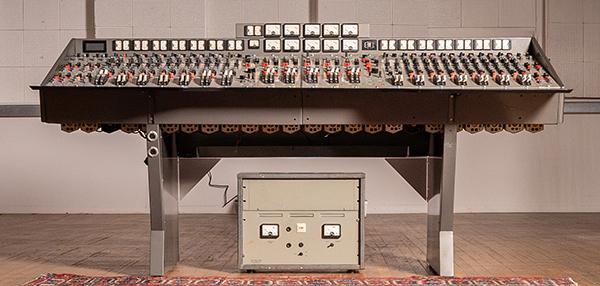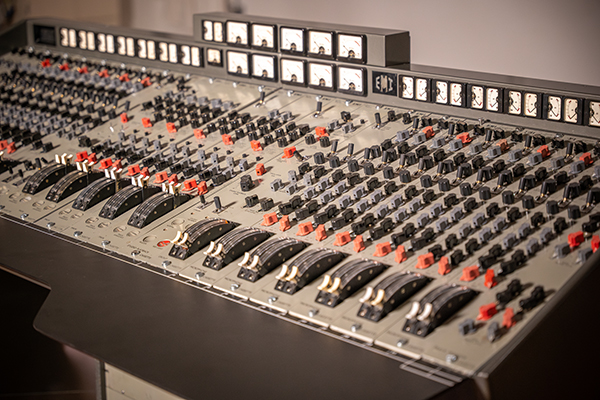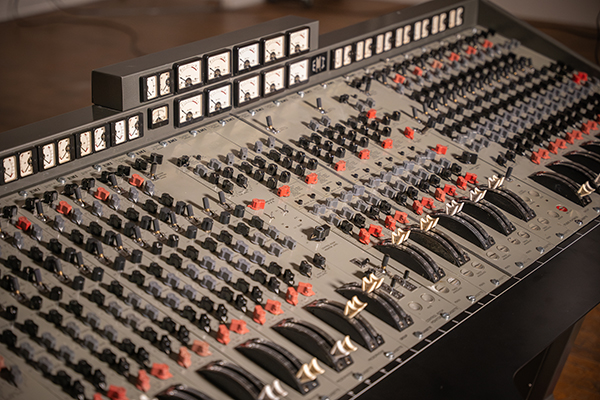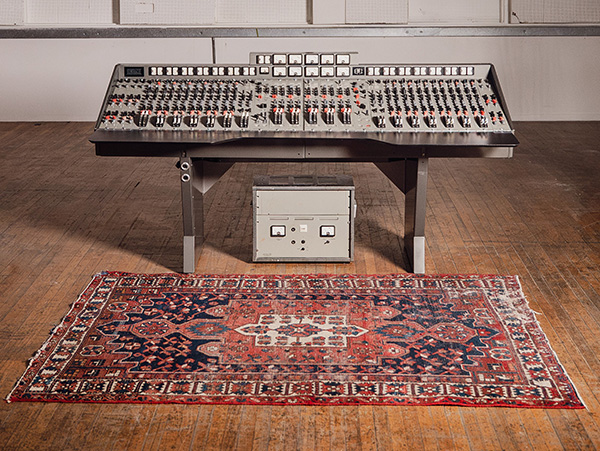I will guess 4.7 million.
Keep in mind, it's hard to make predictions, especially about the future.

The music you make is equal to the console you make it on — or something like that. To that end, mega online gear retailer Reverb has just announced that the EMI TG12345 recording console used by The Beatles to record September 1969’s seminal Abbey Road LP is going up for sale through MJQ Ltd., their official artists partner, starting on October 29, 2024.
The now fully restored, one-of-one EMI TG12345 recording console was custom-built for EMI Studios in 1968, and it was used the following year to record the August and September 1969 sessions for the Fab Four’s aforementioned studio swan-song LP on Apple, Abbey Road.

“Abbey Road is one of the best albums that’s ever been made, and it sounds so good because of this recording console,” believes recording engineer Dave Harries, who participated in numerous Beatles recording sessions utilizing the TG12345 console in the 1960s. “Because of the way Abbey Road was recorded,” Harries continues, “the album has a distinctive sound that hallmarked the future of pop recording.”

Following the recording of Abbey Road, all four members of The Beatles would in turn use that fabled TG12345 console for solo projects, including John Lennon’s Top 5-charting February 1970 single on Apple, “Instant Karma!” For the record, full-on Fab Four solo albums recorded with the TG12345 include Lennon’s December 1970 solo debut on Apple, John Lennon/Plastic Ono Band; Paul McCartney’s April 1970 solo debut on Apple, McCartney; George Harrison’s behemoth 3LP set on Apple, November 1970’s All Things Must Pass; and Ringo Starr’s solo debut on Apple, March 1970’s Sentimental Journey. According to Harries, the console’s sound was “so superior and distinctive” that Harrison asked EMI if he could buy one for himself, only to be turned down for fear that the console would be replicated and sold to one of their competitors (er, as if).
In addition to The Beatles, other artists who recorded albums and singles with the TG12345 include Cliff Richard and The Shadows, The Hollies, Mary Hopkin, Doris Troy, and Billy Preston.

“If you talk to the engineers who have used it, they’ll tell you the same thing: It’s a beautiful sounding machine [. . . and] it enhances everything that goes through it,” observes producer/engineer Mike “The TG Man” Hedges (The Cure, U2), who was the principal client in Studio 2 at Abbey Road Studios throughout the 1980s. “I even once threatened to stop working at Abbey [Road] Studios after being told that they planned to switch from EMI to a different brand of consoles,” The TG Man continues. “That is how I managed to purchase the consoles. A deal was done for me to acquire the replaced consoles.” (Good on ya, fellow Mike!)

After being disassembled and having then sat unused for more than five decades, the TG12345 recording console underwent a five-year restoration process under the guidance of Beatles collaborator and former EMI engineer Brian Gibson. Gibson, along with a team of audio engineers and technicians (some of whom are seen above), managed to reunite the console with 70% of its original parts, working with expert British companies to faithfully reproduce the replacement parts to seamlessly work alongside their older counterparts.
After years of work, Gibson and his team — a number of whom are also providing letters of provenance that will be included with the TG12345’s sale — were said to be able to bring the console to “almost exactly the same form as it was when it sat at EMI Studios” — a locale that has since been known as, of course, Abbey Road Studios, following the release of that key Beatles album. Hedges adds that the console hadn’t been used since Beatles’ solo sessions in the ’70s until just this past autumn, when Reverb gathered artists and engineers at the former home of London’s celebrated Decca Studios to put the recording console to the test ahead of its sale period — as seen in the YouTube clip below.
It should also be noted that the TG12345 — a.k.a. The Prototype, a.k.a. Mk.I — is the first and only prototype console out of the 17 TG consoles made worldwide by EMI. The other 16 consoles were mostly Mk.II and Mk.III models, while two of them were designated as Mk.IV. For the recording geeks amongst us, key features of the TG12345 Mk.I console include 24 microphone inputs, 12x dual microphone cassettes, 4x echo and 2 cue sends, limiter/compressors on every channel (the world’s first), 4 dual main mix, 8 outputs, 2-band EQs, 4-track routing, 4 echo sends, 2 cue sends, remote patchbay (disconnected), power supply, and associated cabling (220VAC).
Additional tech info and restoration specs for the TG12345 recording console are available upon request, as are frequency response readouts that will show “consistent” signal performance across the mic cassettes, and all of it can be obtained via email queries sent to sales@mjq.co.uk.

“This particular console is a one-off. It’s unique. You can’t replace it,” affirms Harries (seen above) of the TG12345. “It sounds so good that it holds up against any modern console — and, in many respects, it’s probably better. Because in those days, it was built to a different standard, cost no object. EMI built this to be the best in the world.”
Alas, the SRP for the storied EMI TG12345 recording console has yet to be announced, though we’ll certainly know what it will be for sure on October 29. But, hey, given that the Mk.I is a one-of-a-kind historical console that’s been part of making music that remains way beyond compare, could any number being asked for it really be too high?
For a fuller preview of the TG12345 on MJQ Ltd., go here.
For more about the TG12345 as it appears on Reverb, go here.


I will guess 4.7 million.
Keep in mind, it's hard to make predictions, especially about the future.

It could become an actual recording room.

So, $6 mil??
This unit should really be in a museum, like all of the other relics of last century (instead of sold to private owners).
Yah, I get that ancient antiquities and other collectibles will never go that route again, but whatever- the entropy of civilization continues.

Wherever it lands, I hope it continues to be used to do the work it was meant to do.

Folks aren't always so prescient when it comes to preserving their cultural heritage. Viz the Firestone building in Brentford.
---
Many years ago I snuck a peek into a storage closet in Abbey Road and saw more tape machines than you can shake a stick at. Some were on shelves but some were just stacked atop one another. Yikes! I imagine they must take more care these days.
---
In the unlikely event anyone asks - I had no official business there but I was able to blag my way in with an acquaintance who did. At the time studio 2 looked just like it does in the old pictures, though the control room upstairs had a modern console.

They didn't get the reserve the first time. They want more than $1millon but I don't know what the actual reserve is.
As memorabilia, it would be terrible (it's very large); but as a working studio console it would be great to track on and use as a summing mixer, but costs way too much. It didn't sell last time, and unless they come down on the price it probably won't sell this time either. Personally, I'd like to see it put back to work but the economics don't make sense (it would never recoup its' cost).
There are other TG12345's out there if you want to build a studio around one. If you want it for memorabilia, it's going to take up as much room as a large sofa and be a real pain to dust. I guess you could run your audio system through it... but it's 220V and runs at +4dBm vs. consumer level of -10dBm (much hotter signal) so caveat emptor. Oh, and good luck finding parts if something fails.

Thank you for providing useful and very good information.
https://k1gamedownload.pro/

This EMI TG12345 console is a piece of music history! It's incredible to think of all the iconic Beatles tracks, and even solo work, recorded on it. The restoration is amazing. It reminds me of how technology shapes art, even in unexpected ways. Speaking of unexpected, have you heard of Miside Game? It's a dating sim with a horror twist, where the virtual world bleeds into reality. It plays with that idea of technology impacting our lives in surprising, sometimes unsettling, ways. Totally different genre, but a similar theme of technology's powerful influence!